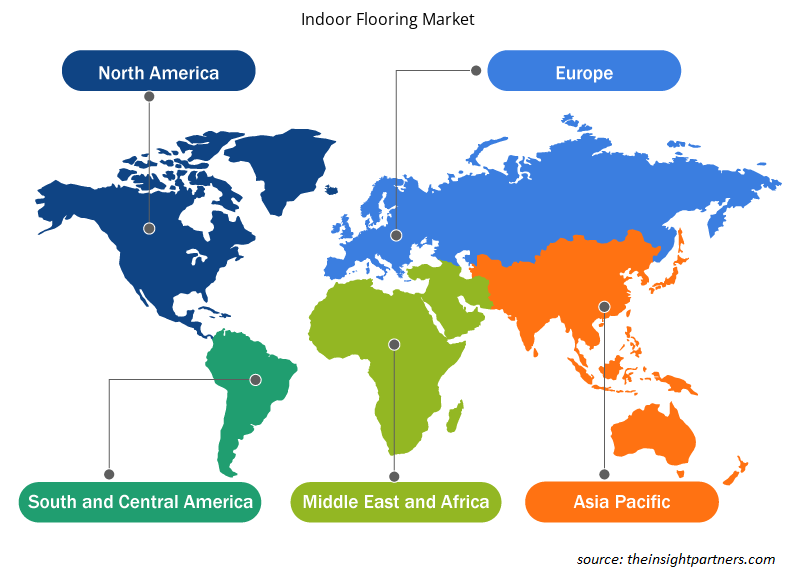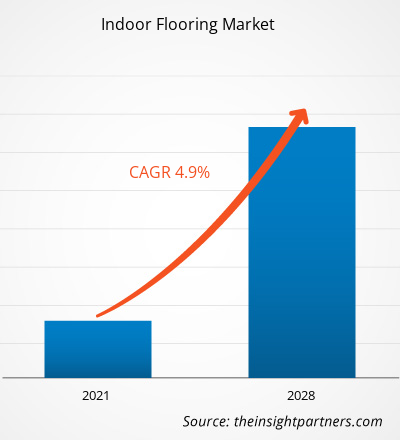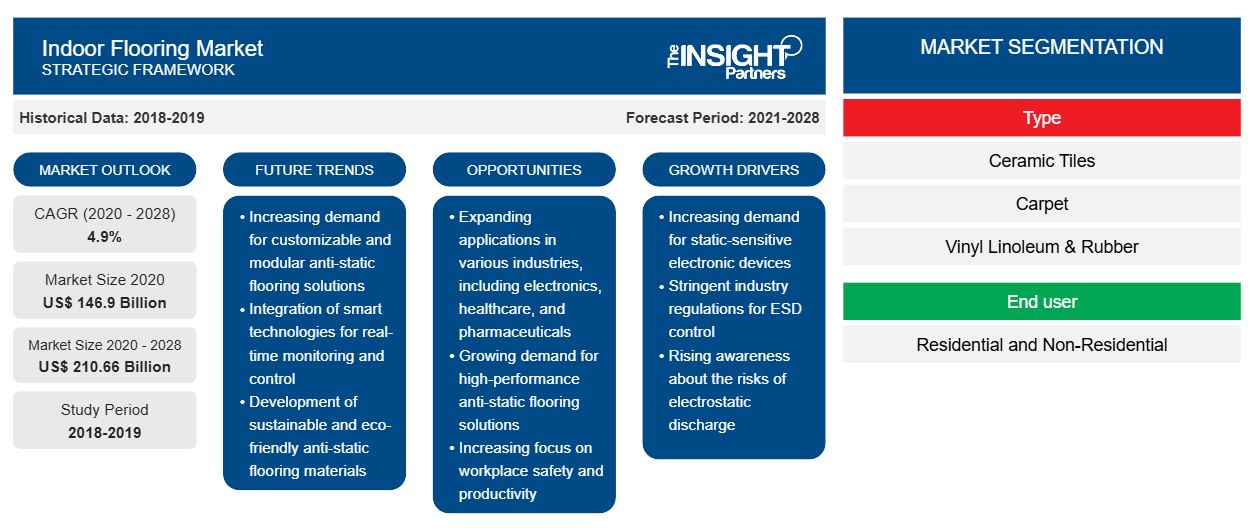[Forschungsbericht] Der Markt für Bodenbeläge für Innenräume wurde im Jahr 2020 auf 146,90 Milliarden US-Dollar geschätzt und wird im Prognosezeitraum von 2021 bis 2028 voraussichtlich mit einer durchschnittlichen jährlichen Wachstumsrate von 4,9 % wachsen.
In industriellen Umgebungen wie Lagerhallen, Flugzeughangars, Montagewerken, Lackierereien, Karosseriewerkstätten und Vertriebsanlagen sind Betonböden durch den Kontakt mit aggressiven und ätzenden Chemikalien und Ölen Verschleiß ausgesetzt; sie können auch durch Kratzer und Abrieb durch schwere Maschinen und Geräte wie Flugzeuge und Gabelstapler beschädigt werden.
Die rasche Industrialisierung und der Aufbau von Fertigungs- und Verarbeitungsanlagen in den Entwicklungsländern im asiatisch-pazifischen Raum treibt die Nachfrage nach Bodenbeschichtungen an, und die Pharma-, Lebensmittel- und Getränke- sowie die Automobilindustrie sind die wichtigsten Nachfragegeneratoren. Multinationale Konzerne in Europa und Amerika weiten ihre Aktivitäten in Entwicklungsländern des asiatisch-pazifischen Raums wie China und Indien aus. Da renommierte Hersteller ihre Betriebsstätten in den Ländern dieser Region errichten, steigt auch die Nachfrage nach Bodenbeschichtungen in Industriequalität. Der Anstieg der Nachfrage hat die Hersteller von Bodenbelägen für Innenräume dazu ermutigt, fortschrittliche und generische Produkte einzuführen und so den Markt für Bodenbeläge für Innenräume anzukurbeln.
Passen Sie diesen Bericht Ihren Anforderungen an
Sie erhalten kostenlos individuelle Anpassungen an jedem Bericht, einschließlich Teilen dieses Berichts oder einer Analyse auf Länderebene, eines Excel-Datenpakets sowie tolle Angebote und Rabatte für Start-ups und Universitäten.
-
Holen Sie sich die wichtigsten Markttrends aus diesem Bericht.Dieses KOSTENLOSE Beispiel umfasst eine Datenanalyse von Markttrends bis hin zu Schätzungen und Prognosen.
Auswirkungen der COVID-19-Pandemie auf den Markt für Innenböden
Der COVID-19-Ausbruch hat die Infrastrukturentwicklung und die Weltwirtschaft erheblich beeinträchtigt. Die internationale Reaktion auf die rasche Störung wichtiger Infrastruktursektoren und -industrien ist im Gange. Laut dem jüngsten Lagebericht der Weltgesundheitsorganisation gehören die USA, Indien, Brasilien, Russland, Großbritannien, Frankreich, Spanien und Italien zu den am stärksten vom COVID-19-Ausbruch betroffenen Ländern. Der Ausbruch begann im Dezember 2019 in Wuhan (China) und hat sich seitdem über den ganzen Globus ausgebreitet. Die COVID-19-Krise hat die Industrien weltweit betroffen. Die Weltwirtschaft wurde im Jahr 2020 negativ beeinflusst, was sich voraussichtlich auch im Jahr 2021 fortsetzen wird. Die Pandemie hat Unternehmen und Lieferanten von Bodenbelägen für Innenräume auf der ganzen Welt in Schwierigkeiten gebracht. Die Marktteilnehmer erlebten Störungen in ihren Betriebsabläufen und werden voraussichtlich bis Mitte 2021 mit den Folgen zu kämpfen haben. Die Fabrikschließungen, Handelsverbote und Grenzschließungen haben sich negativ auf die Branche der Bodenbeläge für Innenräume ausgewirkt. Auf der anderen Seite öffnet sich der Markt im Jahr 2021, sodass erwartet wird, dass er in naher Zukunft an Fahrt gewinnt.
Einblicke in den Markt für Innenbodenbeläge
Zunehmender Einsatz von Bodenbeschichtungen in Sportanlagen
Bodenbeschichtungssysteme für Sporthallen und -plätze im Freien müssen die richtige Kombination von Eigenschaften aufweisen, wie z. B. hervorragende Punktelastizität, Rutschfestigkeit, Oberflächenelastizität und Rückfederung. Sie sollten außerdem extrem haltbar sein und gleichzeitig hervorragende optische Eigenschaften und Kompatibilität mit häufig verwendeten Farbstoffen und Zusatzstoffen aufweisen. Hochleistungsfähige Polyurethan-Bodenbeschichtungen verleihen Oberflächen hervorragende Elastizität und guten Halt und ermöglichen den Spielern gleichzeitig Agilität und geschickte Bewegungen auf dem Platz. Daher sind sie ein bevorzugtes Material für Bodenbeschichtungen in Sporthallen, Tennis-, Volleyball- und Basketballplätzen sowie Wrestling- und Turnhallen. Die steigenden Ausgaben von Regierungen und privaten Bauunternehmen für den Bau von Sportkomplexen und -hallen haben zur Entwicklung zahlreicher Sportanlagen in städtischen und vorstädtischen Gebieten geführt, die in den kommenden Jahren wahrscheinlich eine hohe Nachfrage nach speziellen Hochleistungs-Bodenbelägen für den Innenbereich erzeugen werden.
Typbasierte Markteinblicke
Der Markt für Bodenbeläge für Innenräume wird nach Typ in Keramikfliesen, Teppich, Vinyl-Linoleum und Gummi, Holz und Laminat und andere unterteilt. Das Segment Keramikfliesen dominiert den Markt für Bodenbeläge für Innenräume. Keramikfliesen werden häufig verwendet, um die Böden von Häusern, Krankenhauszimmern und Toiletten zu verschönern. Sie sind auf dem Markt in großer Menge erhältlich. Keramik ist auch als Porzellan bekannt. Keramikfliesen werden auch für Fußböden und Wände verwendet. Sie sind in einer breiten Palette von Varianten basierend auf Texturen, Mustern und Größen erhältlich. Auf den globalen und lokalen Märkten bieten viele Akteure verschiedene Arten verwandter Produkte an.
Die Akteure auf dem Markt für Innenböden konzentrieren sich auf Strategien wie Fusionen, Übernahmen und Marktinitiativen, um ihre Positionen auf dem Markt zu behaupten. Nachfolgend sind einige Entwicklungen der wichtigsten Akteure aufgeführt:
- Laut staatlichen und lokalen Wirtschaftsentwicklungsquellen investierte die Shaw Industries Group im Jahr 2020 20 Millionen US-Dollar in den Bau neuer Räumlichkeiten in Ringgold. Das Unternehmen plant, die neuen Räumlichkeiten in Ringgold am oder um den 1. Juni 2021 zu beziehen.
- Im Jahr 2018 erweitert Interface seine Reichweite im Bereich Performance Flooring durch die Übernahme einer Rubber Flooring Company
Regionale Einblicke in den Markt für Innenbodenbeläge
Die regionalen Trends und Faktoren, die den Markt für Innenböden im Prognosezeitraum beeinflussen, wurden von den Analysten von Insight Partners ausführlich erläutert. In diesem Abschnitt werden auch Marktsegmente und Geografie für Innenböden in Nordamerika, Europa, im asiatisch-pazifischen Raum, im Nahen Osten und Afrika sowie in Süd- und Mittelamerika erörtert.

- Erhalten Sie regionale Daten zum Markt für Innenbodenbeläge
Umfang des Marktberichts für Innenböden
| Berichtsattribut | Details |
|---|---|
| Marktgröße im Jahr 2020 | 146,9 Milliarden US-Dollar |
| Marktgröße bis 2028 | 210,66 Milliarden US-Dollar |
| Globale CAGR (2020 - 2028) | 4,9 % |
| Historische Daten | 2018-2019 |
| Prognosezeitraum | 2021-2028 |
| Abgedeckte Segmente |
Nach Typ
|
| Abgedeckte Regionen und Länder |
Nordamerika
|
| Marktführer und wichtige Unternehmensprofile |
|
Marktdichte von Bodenbelägen für Innenräume: Auswirkungen auf die Geschäftsdynamik verstehen
Der Markt für Bodenbeläge für Innenräume wächst rasant. Dies wird durch die steigende Nachfrage der Endverbraucher aufgrund von Faktoren wie sich entwickelnden Verbraucherpräferenzen, technologischen Fortschritten und einem größeren Bewusstsein für die Vorteile des Produkts vorangetrieben. Mit der steigenden Nachfrage erweitern Unternehmen ihr Angebot, entwickeln Innovationen, um die Bedürfnisse der Verbraucher zu erfüllen, und nutzen neue Trends, was das Marktwachstum weiter ankurbelt.
Die Marktteilnehmerdichte bezieht sich auf die Verteilung von Firmen oder Unternehmen, die in einem bestimmten Markt oder einer bestimmten Branche tätig sind. Sie gibt an, wie viele Wettbewerber (Marktteilnehmer) in einem bestimmten Marktraum im Verhältnis zu seiner Größe oder seinem gesamten Marktwert präsent sind.
Die wichtigsten auf dem Markt für Innenbodenbeläge tätigen Unternehmen sind:
- Forbo International SA
- Mats Inc.
- Tarkett
- Armstrong Flooring, Inc.
- Beaulieu International Gruppe
Haftungsausschluss : Die oben aufgeführten Unternehmen sind nicht in einer bestimmten Reihenfolge aufgeführt.

- Überblick über die wichtigsten Akteure auf dem Markt für Innenbodenbeläge
Der globale Markt für Bodenbeläge im Innenbereich ist wie folgt segmentiert:
Globaler Markt für Innenböden – nach Typ
- Keramikfliesen
- Teppich
- Vinyl Linoleum & Gummi
- Holz und Laminat
- Sonstiges
Globaler Markt für Innenböden – nach Endverbraucher
- Wohnen
- Nicht-Wohngebäude
Globaler Markt für Innenböden – nach Geografie
-
Nordamerika
- UNS
- Kanada
- Mexiko
-
Europa
- Frankreich
- Deutschland
- Italien
- Russland
- Vereinigtes Königreich
- Restliches Europa
-
Asien-Pazifik (APAC)
- China
- Indien
- Japan
- Australien
- Südkorea
- Restlicher Asien-Pazifik-Raum
-
Naher Osten und Afrika (MEA)
- Saudi-Arabien
- Vereinigte Arabische Emirate
- Südafrika
- Rest von MEA
-
Süd- und Mittelamerika (SCAM)
- Brasilien
- Argentinien
- Rest von SCAM
Firmenprofile
- Forbo International SA
- Mats Inc.
- Tarkett
- Armstrong Flooring, Inc.
- Beaulieu International Gruppe
- Ecore International
- Schnittstelle, Inc.
- Toli Corporation
- Mohawk Industries, Inc.
- Shaw Industries Group, Inc.
- Historische Analyse (2 Jahre), Basisjahr, Prognose (7 Jahre) mit CAGR
- PEST- und SWOT-Analyse
- Marktgröße Wert/Volumen – Global, Regional, Land
- Branchen- und Wettbewerbslandschaft
- Excel-Datensatz
Aktuelle Berichte
Erfahrungsberichte
Grund zum Kauf
- Fundierte Entscheidungsfindung
- Marktdynamik verstehen
- Wettbewerbsanalyse
- Kundeneinblicke
- Marktprognosen
- Risikominimierung
- Strategische Planung
- Investitionsbegründung
- Identifizierung neuer Märkte
- Verbesserung von Marketingstrategien
- Steigerung der Betriebseffizienz
- Anpassung an regulatorische Trends























 Kostenlose Probe anfordern für - Markt für Innenböden
Kostenlose Probe anfordern für - Markt für Innenböden